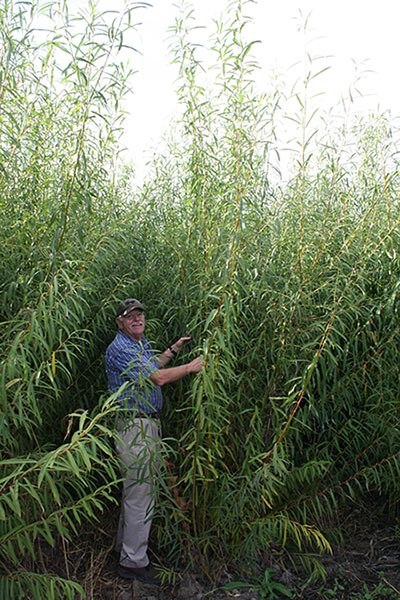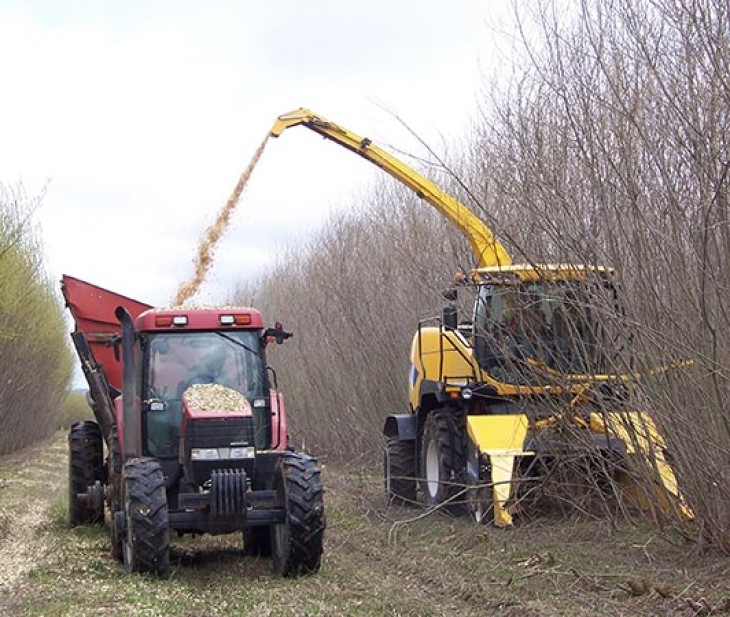As communities in the Northeast look for green fuels to replace coal and oil, they are exploring options in woody biomass, including plantings of shrub willow. Our forests will certainly play a key role in sustaining regional biomass plants, but what about on a smaller scale? Might it become feasible for landowners to grow their own short-rotation woody-biomass crops? Proponents of willow fuel say yes.
In the same way that switchgrass is being cultivated as a low-maintenance agro-fuel on marginal southern farmland, shrub willow may become a viable crop for northern tree farmers. Shrub willow is grown in plantations and coppiced after the first year. By the third or fourth year it reaches harvestable size, and it can be harvested every three years for up to seven cycles before replanting.
With a per-acre growth rate 5 to 10 times that of natural forests, willow could help stabilize supply as demand rises for sustainable-source woody biomass.
Middlebury College in Vermont is experimenting with growing its own willow as supplemental fuel for its wood-chip heating plant. “We’re doing it not only to be carbon neutral by 2016, but also to help supplement wood that’s produced by the forest products industry,” says Tom Corbin, director of business services. “When the heating season starts, willow can take pressure off the chip market to keep prices from spiking.”
The college, aided by SUNY-College of Environmental Science and Forestry and Cornell University, has planted nine acres of test beds. They hope to generate enough volume per acre, at the right moisture and Btu levels, to work in their gasifier. Their first harvest is scheduled for 2010.
Research conducted by SUNY-ESF and Cornell suggests that the trial has promise. Larry Abrahamson, senior research associate at SUNY-ESF, reports that willow plantations can yield 4 to 5 oven-dried tons per acre per year. When dried, willow is roughly half (45–48 percent) its green weight. Larry Smart, associate professor at Cornell, summarizes: “On a small scale, you can cut and chip five acres in a day with one tractor and two trucks, harvesting at least 120 green tons, enough to supply heating fuel for a farm for an entire season.” This could serve facilities such as rural schools, dairy and greenhouse operations, and hospitals and municipalities that own land.
“On a larger scale, 10 acres is the lower limit to be worthwhile for bringing in harvesting equipment,” notes Abrahamson. Because willow is harvested after leaf-fall, the same equipment used for forage crops can move on to willow by simply changing the cutting head. Willow grows on both unused and marginal crop land, opening up options for farmers and local supply chains.
Growing willow for fuel began in Sweden after the 1970s oil crisis. The British Isles followed suit. Cultivation in the Northeast started in 1986 at SUNYESF as part of a research grant for alternative fuel crops. Although work continues on developing willow for liquid fuel, phytoremediation (soil decontamination), erosion control, and snow fencing, willow shows greatest promise for combined heat and power generation. “It’s a feedstock that can be used for any of them,” says Tim Volk, Senior Research Associate at SUNY-ESF.
Volk believes that willow for heating will come on strong in the Northeast. “But I don’t see it as competing with forestry products,” he says. Rather, “we need to develop the biomass industry together.”
New York and Vermont have an abundance of agricultural land, so it makes sense that these states are looking into dedicated energy crops like willow to supplement their working forests. New Hampshire and Maine have less open land, but people in both states are expressing interest. Recently, says Smart, “there has been commercial interest in using willow for local power production in Maine, and we’ve had conversations with a pellet manufacturer with a plant in New Hampshire.” Organizations in Michigan, Minnesota, Wisconsin, Virginia, Pennsylvania, Connecticut, and Canada are also exploring willow’s potential. SUNY-ESF has licensed a New York nursery, Double A Willow, to provide commercial planting stock.
Research is focusing on high-yield breeding stock for colder climates. Early SUNY-ESF trials with Swedish stock revealed a susceptibility to potato leaf hopper, which, says Smart, “highlighted a need to develop alternative species suited for North America.” Successful plantations mix four to six species. “We’re still sorting out which perform best in different climates,” Smart says.
Corbin adds: “Although initial cultivation is very intensive, after the first year there’s relatively little to do. You need a lot of land and cash to get started, but it pays back after the third harvest.”
The biomass industry will be watching Middlebury’s results with interest. Assuming the trials perform as expected, the college plans to expand to 400 acres per year for 3 years. Their goal is 25 green tons per acre at each harvest.
“Even if it doesn’t work for us, it might work for somebody else,” Corbin says. “The concept of energy independence is high on the radar right now.”




Discussion *